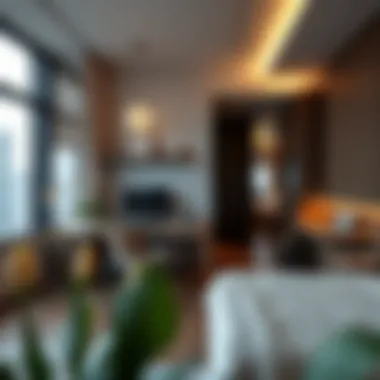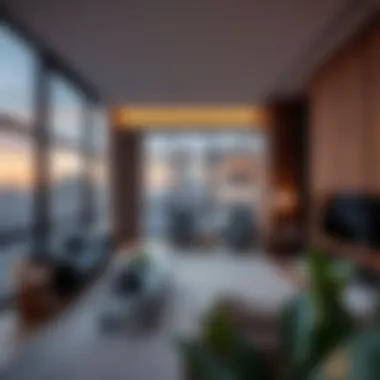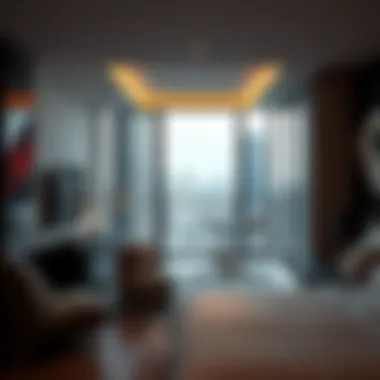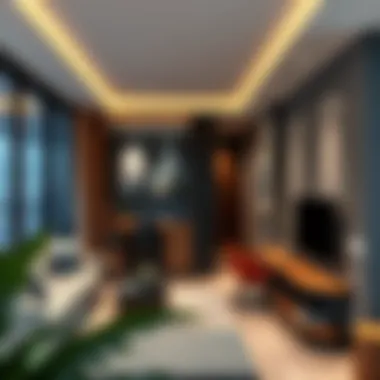Exploring Studio Apartments: Insights and Trends


Intro
Studio apartments, often seen as a modern solution to urban living, increasingly captivate potential homeowners and renters alike. These compact living spaces combine functionality with a sense of style, one that fits seamlessly into the hustle and bustle of city life. As the architectural scene evolves, and housing demands shift, studio apartments have carved out a niche that appeals to both singles and couples seeking flexibility.
Dubai, a city bursting at the seams with opportunity, showcases a unique landscape for studio living. The real estate market here reflects shifting demographics and evolving lifestyles, making it crucial for potential buyers and investors to grasp the prevailing trends. In this piece, we will journey through the intricacies of studio apartments, exploring their distinct characteristics, practical benefits, and inherent challenges.
By delving into the design elements that make a studio apartment feel spacious and welcoming despite limited square footage, we'll underscore what sets these spaces apart. Furthermore, it’s essential to consider the affordability aspect in today’s economy, where property prices can run the gamut. Ultimately, this guide will deliver a detailed roadmap for individuals navigating the waters of studio apartment living—be it buying, renting, or investing.
Defining the Studio Apartment
Defining what a studio apartment is goes beyond a mere description of a living space. In today’s fast-paced world, particularly in urban settings, these compact apartments represent a lifestyle choice for many. Studio apartments are not just a type of dwelling; they embody the need for simplicity, affordability, and efficiency. As cities become more crowded, the studio apartment stands out as a practical solution for individuals who value their independence while navigating the challenges of urban living. Understanding this type of residence is crucial not only for potential renters and buyers but also for real estate investors and developers who are attuned to market trends.
Key Characteristics
When talking about studio apartments, certain key characteristics come to mind:
- Open Layout: Unlike traditional apartments, studio apartments have an open-concept layout that combines living, sleeping, and kitchen spaces into one room. This fluidity provides flexibility in furniture arrangement and design.
- Compactness: Typically, studio apartments range from 300 to 600 square feet. The compact nature makes them ideal for single individuals or couples, enabling them to make use of smaller spaces without feeling overwhelmed.
- Minimal Walls: The lack of numerous walls not only creates an illusion of more space but also fosters a sense of lightness and airiness within the unit.
- Essential Amenities: Most studio apartments come equipped with essential amenities such as a kitchenette, bathroom, and sufficient storage solutions, making them fully functional despite their size.
- Affordability: Given the rising costs of living in cities, studio apartments often provide a more affordable alternative, catering to young professionals, students, and anyone looking for a budget-friendly living option.
Typical Layout and Design
The design and layout of studio apartments are integral to maximizing the available square footage. The layout typically involves a single room that serves multiple purposes, which can be cleverly divided through various design techniques:
- Zone Identification: Homeowners often use furniture, rugs, and color schemes to define distinct areas without the need for physical walls. A strategically placed bookshelf can serve as a divider between the living area and sleeping space, for example.
- Multi-functional Furniture: In studio apartments, especially, furniture plays a pivotal role. Pieces like a Murphy bed that hides away, ottomans that serve as storage, and extendable dining tables become essential as they enhance both space and functionality.
- Natural Light and Ventilation: Well-placed windows not only allow natural light to penetrate the space but also make it feel more welcoming. Good ventilation is also key in preventing any cramped feelings that may arise from small living quarters.
- Decor Elements: The presence of decor—such as art pieces, plants, or carefully chosen lighting—can add character to the unit, turning a small space into a personal sanctuary.
Historical Context
Understanding the historical context of studio apartments is crucial to appreciate their evolution and significance in the contemporary housing market. This section sheds light on why studio apartments emerged and how they transformed over time. Historical insights also help buyers and investors grasp the nuances of urban living.
Origins of Studio Apartments
The concept of studio apartments isn’t new. In fact, the origins go back to the early 20th century when artists began seeking affordable living spaces in urban areas. The rise of industrial cities during this period saw many individuals moving away from rural life in search of work. As cities expanded, the demand for housing surged. The idea of a compact living space became appealing for those wanting to avoid long commutes and high rents.
It was in bohemian neighborhoods like Montmartre in Paris, where artists found inspiration and comfort in small, integrated spaces. These early studio apartments often forgoed traditional rooms in favor of open designs that encouraged creativity. Artists like Picasso lived and worked in these types of spaces, leading to a surge in their popularity.
Key elements that defined these early studios were simplicity and functionality. They were often furnished minimally but were ideal for those seeking a live-work environment. The concept blended living space and workspace which, in the bustling heart of cities, catered to the lifestyle of the creatives.
Evolution Through Decades
As the decades rolled on, the evolution of studio apartments reflected broader social and economic changes. The 1940s and 50s brought about a post-war housing crisis in many urban centers. With returning soldiers and a surge in population due to the baby boom, demand for affordable housing continued to climb. Studios emerged not just as spaces for artists, but as practical housing options for young professionals and couples. These apartments started to gain traction in areas like New York City and London, reflecting the shift in societal norms around single living and independence.
The 1960s and 70s saw these units further evolve, with architecture embracing modernism. Larger windows, open floor plans, and integrated kitchens became the norm. The minimalist design was popular among those who desired a simpler lifestyle.
Entering the late 20th century and early 21st century, globalization led to a significant rise in urbanization. Cities became melting pots, attracting young individuals from various backgrounds. Studio apartments adapted to meet these changing demographics. Features like smart storage solutions and multifunctional furniture became essential, allowing residents to maximize limited space in increasingly densely populated areas.
"Studio apartments have always been a compromise, but they are a smart choice for many city dwellers who value location and affordability."
In today's context, studios serve not only as living spaces, but also as significant investments. They offer potential for financial growth and, as the globalization of work continues, they accommodate the mobile lifestyle many individuals now embrace. Candidates for these apartments include not only single professionals but also young families and retirees. The market has diversified, reflecting the varied interests and needs of the evolving urban population.
This historical journey showcases how studio apartments have transformed into dynamic living spaces. Understanding this context adds value for potential buyers and investors looking at the unique opportunities that studio apartments hold in the realm of urban real estate.
Popularity in Urban Settings
In recent years, studio apartments have gathered a great amount of attention, especially in urban landscapes. The shift towards smaller, more efficient living spaces responds to a combination of lifestyle changes and economic pressures. This phenomenon is not merely a trend; it signifies a broader movement towards redefining what home means in bustling city environments.
The allure of studio apartments primarily lies in their affordability and practicality, especially in cities where space is at a premium. Urban dwellers often find themselves seeking a home that can accommodate their fast-paced lifestyle. Living in a studio not only offers essential amenities but also promotes a simpler, minimalist approach to day-to-day living.
Market Demand


The demand for studio apartments is palpable in urban centers, where young professionals flock for job opportunities. Cities like New York, London, and Dubai are particularly significant for this market. Young adults, or those just starting their careers, often prefer the cost-effective nature of studio apartments, as they tend to be less expensive than one-bedrooms or larger units.
- Flexibility: Studio apartments cater to a transient lifestyle, ideal for individuals who may not want to commit to long-term leases or extensive renovations.
- Location: Many studios are situated in prime city areas, granting residents easy access to work and social activities.
- Alternative Living: The urban experience often encourages a desire for communal living, as studios can help forge connections among neighbors.
Impact of Economic Factors
Economic influences play a vital role in shaping the popularity of studio living. In a climate where housing prices seem to soar at dizzying speeds, many people find themselves navigating tight budgets while trying to maintain a desirable lifestyle. The result? An uptick in studio apartment interest.
Discussing economic factors, consider the following points:
- Rising Prices: With the cost of living increasing in many metropolitan areas, residents are often left with no choice but to downsize unless they have significant disposable income. Studios present a practical solution.
- Rental Market: As more people gravitate towards renting rather than buying, studio apartments accommodate renters looking for a cost-effective alternative to larger spaces.
- Investment Potential: For investors, studio apartments become attractive assets. Their consistent demand can yield good returns, particularly in high-demand city locations.
"In the shifting tides of urban living, studio apartments stand as a beacon of possibility for many looking to make their way without the burden of a high cost."
Ultimately, the surge in studio apartments resonates with many urbanites, driven not just by a market demand, but also a changing landscape of lived experiences. The migration towards smaller living spaces encapsulates an entire generation's aspirations, values, and economic realities.
Advantages of Living in a Studio Apartment
Living in a studio apartment can often raise an eyebrow among those who prefer traditional larger spaces. However, as urban environments become increasingly dense and housing prices soar, studios represent an appealing alternative. This section highlights the myriad of advantages studio living presents. Understanding these benefits can play a crucial role for investors, buyers, agents, developers, and sellers, providing insight into how these compact yet functional spaces can cater to modern urban living.
Cost-Effectiveness
One of the most lauded advantages of studio apartments is their cost-effectiveness.
- Affordability: Renting or purchasing a studio can often be less expensive than larger apartments, making them a popular choice for those trying to stick to a budget. In markets like Dubai, where property prices are as high as a kite, saving on rent or mortgage can be a game-changer. This means lower utility bills on top of the reduced rent.
- Lower Overhead: With less square footage, the costs associated with maintaining a studio, including heating, cooling, and upkeep, tend to be lower. Residents can enjoy the benefits of modern amenities without breaking the bank, which is particularly appealing to young professionals or transient workers.
"A studio unit can provide the ideal entry point into city life without heavy financial burdens."
Efficiency in Space Utilization
Studio apartments might not boast expansive square footage, but they shine in terms of efficient space utilization.
- Design Optimization: Every inch matters in a studio, leading to clever architectural designs that maximize functionality. Open floor plans provide flexibility to reconfigure living areas as needed. In contrast to traditional layouts with separate rooms, the open layout encourages creativity in furnishing and decorating.
- Multi-functional Spaces: Residents can creatively arrange furniture to serve multiple purposes. For instance, a sofa can double as a guest bed, while tables can serve as both dining hubs and workspaces. This versatility is essential for maximizing small living areas.
- Minimalist Living: Such efficiency encourages residents to adopt a minimalist lifestyle, focusing on essentials rather than accumulating clutter. This mindset can bring a sense of peace and simplicity, especially in the hustle and bustle of city life.
Flexibility and Mobility
Flexibility is another significant advantage of living in a studio apartment, an essential quality in today’s fast-paced world.
- Easier Relocation: For young professionals or individuals whose careers demand frequent moves, studio apartments offer manageable living spaces that are simpler to pack up and relocate. If an opportunity arises across town or in a different city, transitioning to a new home can be as easy as packing a few boxes.
- Short-Term Rentals: Studios are sought after in the short-term rental market. Investors can tap into this potential, finding that the compact units appeal to a broad range of renters, including tourists and business travelers. Owning a studio can thus be a strong investment strategy in urban areas.
- Lifestyle Adaptability: The compactness of studios allows individuals to adapt their living spaces to suit various life changes—whether it’s moving in with a partner or changing jobs. Every change in lifestyle can be embraced without feeling cramped.
Challenges of Studio Living
Living in a studio apartment presents a range of unique challenges. While such spaces offer several benefits, they also bring along some hurdles that need addressing. Understanding these challenges allows potential renters and buyers to make informed decisions. In urban environments, where studio apartments are increasingly popular, a realistic approach to the potential downsides is essential.
Limited Space
One of the most significant challenges of studio living is the limited space. Even though studios are designed for efficiency, the lack of square footage can feel confining, especially for individuals used to more extensive living arrangements. Inhabitants often find they have to prioritize their belongings and be selective about what furniture they bring into their new home.
Here are some notable aspects of limited space in studio apartments:
- Multifunctional Furniture: Living in smaller spaces necessitates the use of multifunctional furniture. A sofa that doubles as a bed or a coffee table with storage can enhance functionality. Without these clever options, managing day-to-day life can become cumbersome.
- Decluttering: The limitation of available space is an excellent motivator for decluttering. It pushes residents to consider what they genuinely need and throw out or donate what they do not use often. This can lead to a simpler, more organized life but may also be an emotional process for some.
- Design Choices: Decor can be tricky. Choosing colors and styles that enhance the illusion of space is often necessary. Lighter shades and mirrors can create a larger feel, but it also requires creativity and careful planning.
"Embracing the essence of minimalism can be both liberating and challenging, particularly in a compact living environment."
Privacy Concerns
Another hurdle is the matter of privacy. Studio apartments, by design, are open and often lack separate rooms. For those who value personal space, this can lead to discomfort, especially if one shares the unit with another person. The closeness can foster connection, but it can also hindert one's ability to have solitude or to engage in personal activities without feeling on display.
Considerations surrounding privacy in studio living include:


- Noise Levels: Sound carries easily in open spaces. This can be particularly disruptive during work hours or late-night activities. Accommodating quiet times can become a tricky aspect of living in a shared studio.
- Personal Space: When sharing a studio, personal activities such as phone calls or hobbies may require negotiation over time and space. This often necessitates open and honest communication.
- Social Dynamics: The proximity means that if guests visit or if there's any bustle happening, it can impact both parties living there. Extra consideration for each other's comfort becomes paramount.
Navigating these challenges is a part of the studio living experience. Each issue can prompt innovative solutions that can transform the space into a more functional and enjoyable living environment. While studio apartments may present certain difficulties, understanding these challenges prepares individuals to tackle them head-on, fostering a rewarding experience.
Design Solutions for Studio Apartments
Designing a studio apartment requires an eye for functionality, creativity, and style. In a space where every square foot counts, the right design solutions can dramatically enhance livability. Efficient design not only optimizes the space but also reflects the personality and lifestyle of those living in it. Understanding the significance of various design elements helps in creating a nurturing environment that meets practical needs while providing comfort.
Innovative Furniture Options
One of the most effective ways to maximize the utility of a studio apartment is through innovative furniture choices. These are not simply about aesthetics but also about how well pieces can adapt to the limited space. For instance, multi-functional furniture has surged in popularity. Imagine a sofa that folds into a bed, or an ottoman that doubles as a storage unit. These kinds of designs allow residents to utilize their living area without cluttering it with unnecessary items.
Another exciting option is modular furniture. These pieces can be rearranged and customized according to one's needs. A dining table that can extend during dinner parties and contract when it’s just for one makes all the difference. And let’s not overlook wall-mounted desks or foldable workstation tables. They tuck away neatly, freeing up floor space when not in use.
"Design is not just what it looks like and feels like. Design is how it works." – Steve Jobs
When selecting furniture, consider scale and proportion. Large, bulky pieces can easily overwhelm a small studio, while sleek, streamlined designs maintain an airy feel. Color also plays a key role. Light-colored furniture can brighten and open up a space, creating an illusion of depth and space.
In terms of style, blending different aesthetics can add character. A contemporary piece in bright hues next to vintage items creates a cozy, yet modern vibe that speaks to a personal story. Investing in furniture that fits the studio's overall design theme while retaining versatility ensures it serves its purpose effectively, all while looking aesthetically pleasing.
Creative Storage Solutions
Storage can be a significant challenge in a studio apartment. However, this embraces a whole new world of creativity. The integration of clever storage solutions resonates with both form and function. Utilizing vertical space is vital—shelves that reach up to the ceiling not only draw the eye upward but also hold a good number of items.
In addition, consider under-bed storage containers for keeping seasonal clothing or off-season equipment. Using hook systems for shoes or bags by the entrance can keep the floor clear while adding to the decor.
Built-in cabinetry can be a lifesaver. It effectively provides storage without encroaching too much into the living area. Think about creating nooks and hiding spots—like a cozy reading corner that has storage built into benches. This nurtures a blend of relaxation and practicality, essential for studio living.
Also, using furniture that inherently incorporates storage helps create a seamless look. An elegant coffee table with shelves or drawers, for example, keeps living spaces tidy without much effort.
Ultimately, the soul of studio living lies in solving the storage riddle efficiently and artfully. By being innovative and stylish, one can not only embrace the limited space but also enjoy a unique and personal living experience.
For more insights, refer to resources like HomeDesignInstitute and ApartmentTherapy. These sites often highlight contemporary designs that cater to small living spaces.
Studio Apartments in Dubai: A Unique Perspective
The allure of studio apartments in Dubai goes far beyond their compact design. They embody a lifestyle choice that speaks to the urban wanderer, the savvy investor, and those seeking a first foot into the bustling real estate market of this vibrant city. As the landscape of Dubai evolves, so does the role of studio apartments within it, reflecting both current trends and future aspirations.
A studio apartment represents a practical and economical living situation without sacrificing the essence of urban lifestyle. These spaces cater specifically to singles, young professionals, and couples who prefer an accessible and flexible living arrangement while living in one of the most dynamic cities in the world. The recipe for a cozy life in a metropolitan jungle often lies in the ability to adapt, which is exactly what studios offer.
Current Market Trends
The market for studio apartments in Dubai is characterized by a notable shift in demographics and lifestyle preferences. As of late 2023, there has been a marked increase in the demand for these compact units. This change is driven largely by a surge in young professionals relocating to the city, attracted by its burgeoning job market.
Real estate agents in Dubai are seeing a significant uptick in inquiries for studio apartments, particularly in areas like Downtown Dubai and Dubai Marina, where residents enjoy proximity to work and leisure activities. Pricing trends indicate that these units, while still affordable relative to larger apartments, are experiencing appreciation.
Moreover, with the rise of short-term rental platforms, many property owners are choosing to enter the short-let market, transforming their studios into income-generating assets. The flexibility to switch between personal residence and a rental option has become a compelling feature for investors.
- Key trends influencing the market:
- Increased demand from expatriates and young professionals.
- Rise in short-term rentals boosting investment potential.
- Urbanization accelerating preference for living in compact, accessible spaces.
Investment Opportunities
For investors, studio apartments in Dubai present a wealth of opportunities. The combination of demand and the relatively lower price point compared to two-bedroom or larger units makes studios an appealing choice for those looking to enter the real estate market without breaking the bank.
Several developers in Dubai are recognizing this trend and are now constructing new high-rise buildings focused exclusively on studio apartments. Investing in these developments can yield high returns, especially given the city's ongoing growth and development initiatives.
Furthermore, the potential for capital gains is significant as the city continues to expand its infrastructure and amenities, making living in a studio not just a convenience, but a smart financial decision.


"Investing in studio apartments in Dubai can be a strategic way to capture the evolving market, where space is as valuable as the lifestyle it offers."
The real estate market in Dubai is also supported by favorable regulations for foreign investors. Laws permitting 100% ownership in certain freehold areas provide an accessible gateway for those outside the UAE seeking to invest.
- Considerations for potential investors:
- The reputation of the developer and the quality of construction.
- Location: areas with high demand and future growth prospects.
- Property management options, particularly if pursuing short-term rentals.
As the urban tapestry of Dubai continues to evolve, studio apartments will likely stay in the spotlight, offering both a lifestyle solution and a lucrative investment for those willing to dive into this unique market.
Considerations for Buyers and Renters
When diving into the world of studio apartments, both buyers and renters have a plethora of factors to weigh before signing on the dotted line. The allure of compact living can be enticing, particularly in bustling urban centers where space often comes at a premium. However, understanding the intricacies related to legal regulations and financial implications is key to making informed decisions.
Understanding Legal Regulations
Navigating legal regulations can be a tricky affair, especially in big cities like Dubai. Zoning laws, building codes, and lease agreements vary significantly, and they can directly impact the feasibility of living in a studio apartment.
- Zoning Laws: In cities, zoning laws dictate what types of residences can be constructed in certain areas. Some neighborhoods may have restrictions that limit the number of studio apartments. So, checking this can save a potential buyer or renter a world of trouble down the line. It’s advisable to look up local regulations or consult with a real estate agent who specializes in this area.
- Lease Agreements: For renters, understanding the lease agreement is paramount. Certain terms may be included that could pose problems in the future, like renewal terms or conditions for breaking the lease. Ensuring clarity in these agreements can help avoid surprises later on.
- Homeowners Association (HOA) Rules: If you’re purchasing within a building governed by an HOA, familiarize yourself with their regulations. They can impose restrictions on property modifications or even rules around common areas. It’s critical to ask for HOA documentation and thoroughly read through it.
Financial Implications
The financial implications of studio living go beyond just rent or mortgage payments. Here’s a rundown of what to keep in mind:
- Affordability: While studio apartments can be more cost-effective than larger units, it’s important to factor in costs such as utilities, maintenance fees, and property taxes. Reading through monthly costs will provide a clearer picture of overall affordability.
- Potential for Appreciation: Location plays a pivotal role in the value of studio apartments. In areas where urban development is on the rise, property values may appreciate significantly over time. This could be a golden opportunity for investors looking to flip or rent out later.
- Resale and Rental Market Understanding: For buyers, it’s essential to gauge the rental market if considering investment. Is there a high demand for studio apartments in the neighborhood? Understanding what similar units are renting for can help set competitive pricing, should a purchase turn into a rental later.
In summary, considering legal regulations and financial implications is not just an afterthought. It’s a fundamental step towards ensuring a wise investment or rental decision in the studio apartment sector. As the real estate market evolves, being informed empowers both buyers and renters to navigate this compact but complex landscape with confidence.
"Knowledge is power, especially when it comes to making real estate decisions."
For further exploration, useful resources may include governmental sites like usa.gov for local legal regulations or zillow.com for market trends.
Future of Studio Apartments
The prospect of studio apartments continues to evolve. As urban areas keep growing, the need for compact, efficient living solutions becomes paramount. Studio apartments cater to the modern dweller, offering a practical choice for those navigating the fast-paced city environment. Not only do they facilitate a higher density of living spaces, but they also provide affordable options for younger generations and those entering the real estate market.
Emerging Architectural Trends
Architectural design is witnessing a seismic shift driven by sustainability and innovation. In the realm of studio apartments, this means more than aesthetic changes; it encapsulates the functionality of spaces. Here are a few key trends shaping the future:
- Biophilic Design: Integrating nature into living spaces is gaining traction. This involves using natural materials and creating indoor gardens. For instance, vertical gardens and large windows not only enhance beauty but also improve air quality, making studios more appealing.
- Modular Construction: Prefabricated units are becoming more popular. They allow for quick assembly and customization. Think about a modular studio that can be altered easily as requirements change over time. This reflects a growing desire for flexibility.
- Smart Home Technology: Incorporating smart devices can enhance the living experience. From automated lighting to smart thermostats, these gadgets make studio living more convenient and can even save money on utilities.
By embracing these trends, architects and developers can create studio apartments that are not just places to live but also environments that improve well-being and reduce environmental impact.
Impact of Remote Work
The pandemic has fundamentally reshaped how we view work, with remote work becoming a norm rather than an exception. This shift has profound implications for studio apartments. Here are key points to consider:
- Redefining Space Usage: With remote work, the demand for multifunctional spaces has increased. Studios need to accommodate work areas without sacrificing living comfort. Furniture choices like convertible desks and foldable partitions become essential.
- Location Preferences: As more people work from anywhere, there's a notable shift in location preferences. Buyers and renters are less likely to prioritize proximity to offices. Instead, a studio's value might hinge on lifestyle aspects like proximity to parks or cultural hotspots.
- Investment Potential: Investors should keep a keen eye on the changing demands of studio apartments. Properties that meld work and leisure seamlessly will likely see higher demand in the coming years, especially in vibrant urban areas.
In summary, the future of studio apartments is optimistic and adaptable. A blend of innovative design, changing lifestyle patterns, and technology is setting the stage for a new era of urban living. As we look forward, it becomes clear that these compact living spaces are not just surviving; they are evolving to meet the needs of modern inhabitants.
Summary and End
In the ever-evolving landscape of real estate, studio apartments have carved out a notable niche, particularly appealing to urban dwellers and investors alike. This article has ventured into the various dimensions of studio living, laying bare its unique characteristics, historical context, and the challenges and advantages that surround it. Understanding these aspects is crucial because they highlight how studio apartments cater to a specific lifestyle and economic realities prevalent in densely populated cities.
One of the primary benefits of this exploration is the recognition of affordability as a key selling point. In places like Dubai, where the cost of living can soar, studio apartments offer a viable option for those entering the housing market. Not only do they present an economical choice for renters, but they also symbolize innovation in space utilization.
Furthermore, the discussion surrounding design solutions has showcased how creativity can transform limited spaces into practical, comfortable living quarters. As people increasingly prioritize functionality in their homes, the adaptability of studio apartments stands as a testament to modern living trends. It’s about making the most out of what one has, an increasingly relevant sentiment in today's fast-paced world.
However, it’s also essential to acknowledge the challenges that accompany this lifestyle. Limited space may lead to a lack of privacy, and without careful planning, the compactness of a studio can quickly become overwhelming. Understanding these nuances is vital for potential buyers and renters. Evaluating personal needs, lifestyle habits, and future aspirations should play a significant role in the decision-making process.
"Living in a studio is not just about minimizing space; it's about maximizing potential!"
In summary, the world of studio apartments is rich with opportunity, interwoven with various considerations that touch upon financial aspects, design innovation, and lifestyle compatibility. As the demand for flexible living arrangements rises, those involved in real estate—whether buyers, investors, or developers—should take a closer look at how studio living can adapt to and even thrive within urban frameworks. The future points toward a more integrated approach, one that values practicality without sacrificing individual expression in living spaces.











